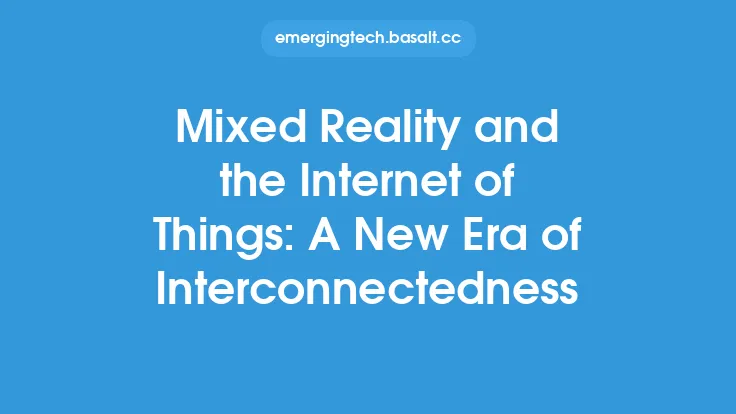Implementing mixed reality solutions can have a significant impact on various industries and aspects of our lives. Mixed reality, which combines elements of both virtual and augmented reality, has the potential to revolutionize the way we interact with information, each other, and the world around us. However, like any emerging technology, it also presents several challenges that must be addressed in order to fully realize its benefits.
Introduction to Mixed Reality Solutions
Mixed reality solutions are designed to blend the digital and physical worlds, creating a more immersive and interactive experience. This is achieved through the use of specialized hardware and software that can track the user's movements, gestures, and surroundings, and then overlay digital information and objects onto the real world. The goal of mixed reality is to create a seamless and intuitive interface between the physical and digital worlds, allowing users to interact with digital information in a more natural and engaging way.
Benefits of Implementing Mixed Reality Solutions
There are several benefits to implementing mixed reality solutions, including increased productivity, improved training and education, enhanced customer experience, and increased accessibility. For example, mixed reality can be used to create interactive and immersive training simulations, allowing users to practice and learn new skills in a safe and controlled environment. Additionally, mixed reality can be used to enhance customer experience by providing users with interactive and engaging product demonstrations, virtual try-on capabilities, and personalized recommendations.
Technical Challenges of Implementing Mixed Reality Solutions
One of the main technical challenges of implementing mixed reality solutions is the need for advanced hardware and software capabilities. Mixed reality requires high-performance computing, advanced graphics processing, and sophisticated tracking and sensing technologies. Additionally, mixed reality solutions must be able to handle complex data processing and analysis, including computer vision, machine learning, and natural language processing. Furthermore, mixed reality solutions must be designed to work seamlessly with a variety of devices and platforms, including smartphones, tablets, and wearable devices.
Challenges of Content Creation for Mixed Reality Solutions
Another challenge of implementing mixed reality solutions is the need for high-quality and engaging content. Creating content for mixed reality requires a deep understanding of the technology and its capabilities, as well as the ability to design and develop interactive and immersive experiences. This can be a time-consuming and costly process, requiring significant resources and expertise. Additionally, mixed reality content must be designed to be accessible and usable by a wide range of users, including those with disabilities and limited technical expertise.
User Adoption and Acceptance of Mixed Reality Solutions
User adoption and acceptance are also critical factors in the successful implementation of mixed reality solutions. Users must be willing to adopt and use mixed reality technology, and they must be able to understand and navigate the interface and functionality of the solution. This requires a user-centered design approach, which takes into account the needs, preferences, and behaviors of the target user group. Additionally, mixed reality solutions must be designed to be intuitive and easy to use, with clear and concise instructions and feedback.
Security and Privacy Concerns of Mixed Reality Solutions
Finally, there are also security and privacy concerns associated with the implementation of mixed reality solutions. Mixed reality solutions often require access to sensitive user data, including location information, personal preferences, and behavioral patterns. This data must be protected and secured, using advanced encryption and authentication technologies. Additionally, mixed reality solutions must be designed to comply with relevant laws and regulations, including those related to data protection and privacy.
Best Practices for Implementing Mixed Reality Solutions
To overcome the challenges associated with implementing mixed reality solutions, there are several best practices that can be followed. These include conducting thorough user research and testing, designing intuitive and user-friendly interfaces, and ensuring that the solution is accessible and usable by a wide range of users. Additionally, it is essential to ensure that the solution is secure and compliant with relevant laws and regulations, and that it is designed to work seamlessly with a variety of devices and platforms.
Future Directions for Mixed Reality Solutions
In conclusion, implementing mixed reality solutions can have a significant impact on various industries and aspects of our lives. While there are several challenges associated with the implementation of mixed reality solutions, these can be overcome by following best practices and taking a user-centered design approach. As the technology continues to evolve and improve, we can expect to see even more innovative and immersive mixed reality solutions in the future. These solutions will have the potential to transform the way we interact with information, each other, and the world around us, and to create new and exciting opportunities for entertainment, education, and commerce.





